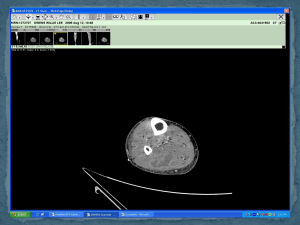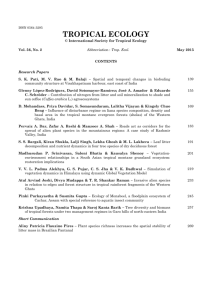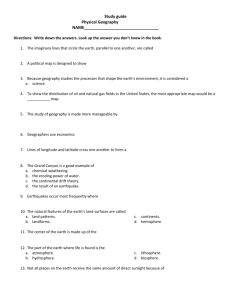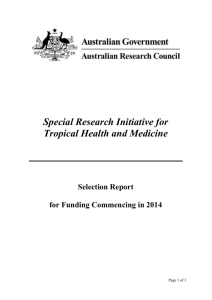Case Report Tropical Pyomyositis : Rare
advertisement
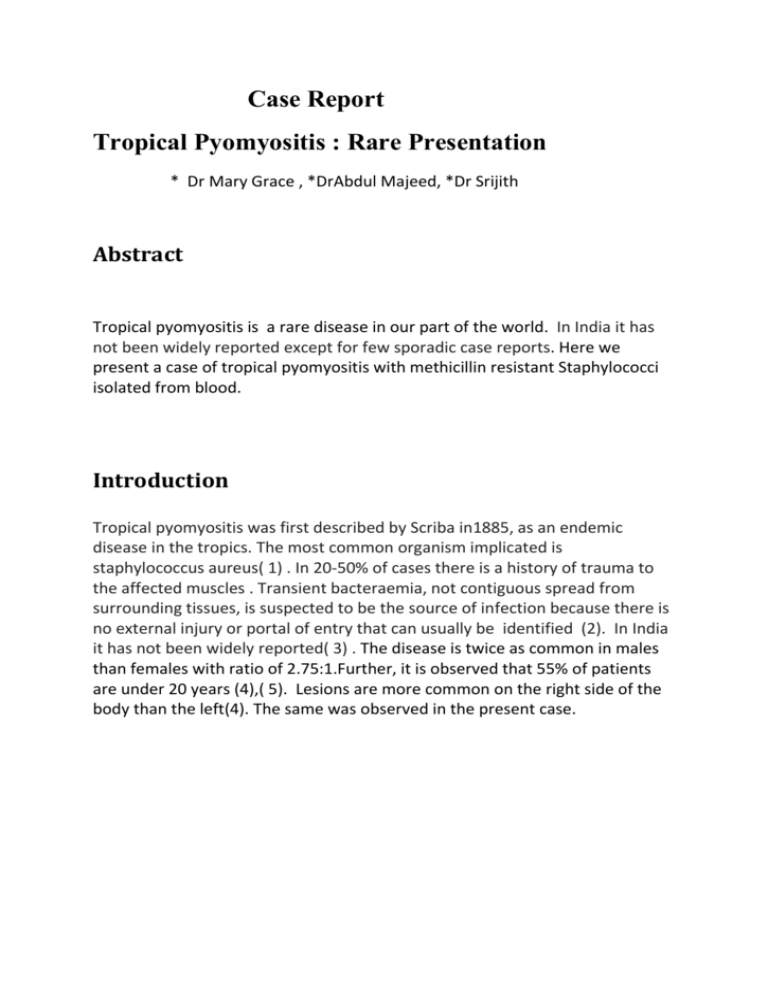
Case Report Tropical Pyomyositis : Rare Presentation * Dr Mary Grace , *DrAbdul Majeed, *Dr Srijith Abstract Tropical pyomyositis is a rare disease in our part of the world. In India it has not been widely reported except for few sporadic case reports. Here we present a case of tropical pyomyositis with methicillin resistant Staphylococci isolated from blood. Introduction Tropical pyomyositis was first described by Scriba in1885, as an endemic disease in the tropics. The most common organism implicated is staphylococcus aureus( 1) . In 20-50% of cases there is a history of trauma to the affected muscles . Transient bacteraemia, not contiguous spread from surrounding tissues, is suspected to be the source of infection because there is no external injury or portal of entry that can usually be identified (2). In India it has not been widely reported( 3) . The disease is twice as common in males than females with ratio of 2.75:1.Further, it is observed that 55% of patients are under 20 years (4),( 5). Lesions are more common on the right side of the body than the left(4). The same was observed in the present case. Case history 17 year native of Orissa,working in Kerala as manual labourer,last visited native place 3 months back,without any significant illness in the past,presented to the casualty with complaints of high grade fever without chills and rigor,and associated pain and swelling of right thigh.the Fever lasted only two days .The pain and swelling in the right thigh was followed by similar complaints in the left thigh 2 days later.There was no history of headache ,vomiting,alteration in the level of consciousness,loose stools,vomiting or oliguria. Examination revealed sick looking patient with tachycardia,tachypnoea and hypotension and tender indurated swelling in both thighs. Other systemic examinations were unrevealing. The clinical possibilities entertained were leptospirosis, dengue fever, malaria, tropical pyomyositis. Investigations showed haemoglobin of 15.2g% normal total leucocyte count and thrombocytopenia(80,000/mm3).Creatinine phosphokinase was markedly elevated 14,920.Other blood investigations revealed slightly raised transaminases and prerenal failure , no malarial parasites.Leptospiral and Dengue antibodies were negative. USG abdomen and X-ray chest were within normal limits. HIV was negative. The patient was started on inj crystalline penicillin, doxycycline, ,inj metrogyl ,inj cloxacillin.There was worsening of overall status. Blebs started appearing on both legs .and gangrenous changes occurred on the overlying skin.Gram staning of material from the bleb did not show any organism .FNAC from the muscle showed necrotic material, sheets of acute inflammatory cells, suggestive of necrotic inflammatory lesion.MRI showed features of pyomyositis. Photo of the leg showing induration and gangrene of the overlying skin MRI of the patient showing features of pyomyositis. Blood culture grew methicillin resistant staphylococci. Injection Vancomycin and injection Piperacillin and Tazobactum and Linezolid was started. The patient progressed into a stage of sepsis with muliorgan failure and disseminated intravascular coagulation with peripheral smear showing evidence of hemolysis, elevated D-dimer and LDH. Supportive therapy in the form of mechanical ventilataion,vasopressor ,transfusion of blood products were given He succumbed to his illness in spite of intensive management. We are presenting a case of tropical pyomyositis caused by methicillin resistant staphylococci progressing to severe sepsis and disseminated intravascular coagulation. Discussion Tropical pyomyositis is a suppurative infection of skeletal muscles characterised by single or multiple abscesses within the fascial covering of muscles. The quadriceps, glutei, pectoralis major, serratus anterior, biceps, iliopsoas, gastrocnemius, abdominal and spinal muscles are commonly involved. Usually a single group of muscle is affected, but in 12-40% of cases multiple groups are involved either sequentially or simultaneously( 6 ) The pathogenesis is not clear, however, it is postulated that un-injured skeletal muscle is intrinsically resistant to infection because myoglobin binds to iron avidly, which is necessary for growth of the organism but when muscle trauma is present, there is sequestration of elemental iron leading to predisposition for bacterial growth (7). Although the classical presentation is muscle abscess, the hallmark of the disease is not an abscess but finding of myositis on a biopsy specimen of involved muscle. It is characterised by subacute or chronic presentation, with acute presentation occuring infrequently. There are three stages namely, invasive stage lasting 10-12 days, where patient has fever, local swelling, mild pain and tenderness, the affected area has wooden consistency and aspiration yields no pus. The suppurative stage when most patients are diagnosed with distinct muscle swelling and tenderness and pus can be aspirated. In the third stage systemic manifestation of sepsis occurs (7). Blood cultures are positive in only 5% cases(7). Ultrasound and MRI are investigations of choice. Ultrasound may show muscle heterogenicity or purulent collection. MRI is useful to assess the localisation and extension. It shows hyper intense signal in T2 weighted images, hyper intense rim on enhanced T1 weighted images and peripheral enhancement after gadolinium-diethylenetriamene pentaacetatic acid(Gd-DTPA) (8 ). References 1. Chambers HF. The changing epidemiology of Staphylococcus aureus? Emerg Infect Dis 2001; 8:178-82. 2. Warrel DA. Tropical pyomyositis. Oxford textbook of medicine 4th ed. Oxford: Oxford University Press 2003; 3:1251–2. 3.Malhotra P, Singh S, Sud A et al. Tropical pyomyositis: Experience of a tertiary care hospital in north west India. J Assoc Physicians India 2000; 48 (11): 1057-9.. 4.Yusufu 3. Yusufu LMD, Sabo SY, Nmadu PT. Pyomyositis in adults : A 12 year review. Trop Doct 2001; 31: 154-5. 5.Ladipo GO, Fakunle YF. Tropical pyomyositis in the Nigerian Savannah. Trop Geogr Med 1977; 29: 223-8. 6.Chauhan S, Jain S, Varma S,Chauhan SS. Tropical pyomyositis : current perspective. Postgraduate Med J 2004; 80: 267-70 7.Lt Col AN Prasad, Lt Col D Majumdar et al Tropical Pyomyositis : Rare Presentation MJAFI 2006; 62 : 387-388 8. Trusen A, Beissert M, Schultz G, et al. Ultrasound and MRI features of pyomyositis in children. Eur Radiol 2003; 13:1050-5 Dr Mary Grace , Assistant Professor in Medicine GOVERNMENT MEDICAL COLLEGE THRISSUR EMAIL drkjjacob@dataone .in Phone 9446460337,9446940618.
